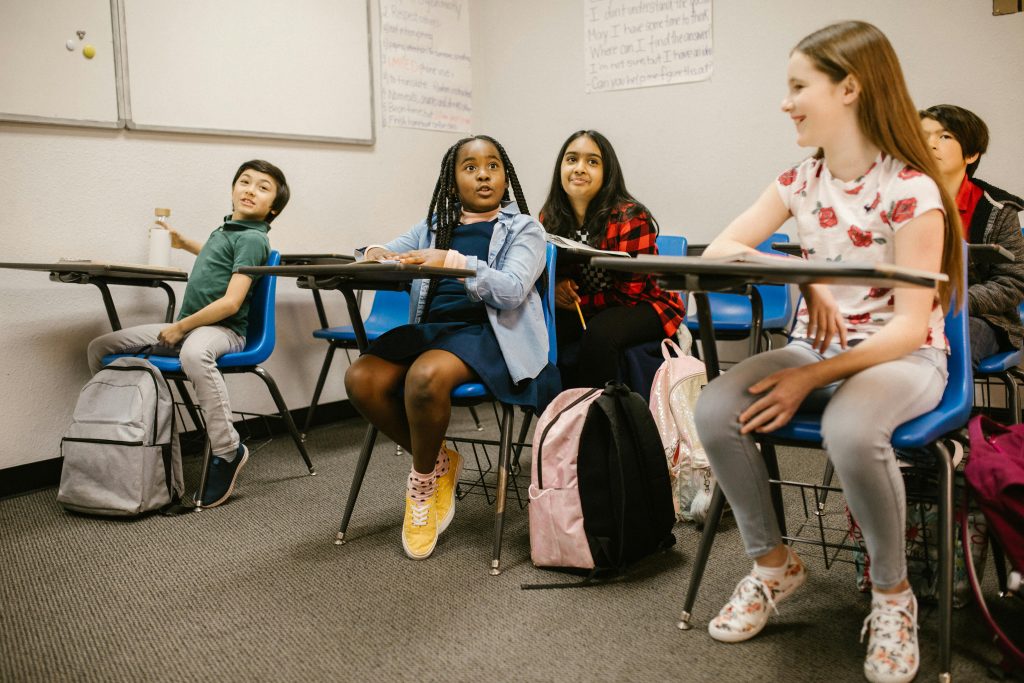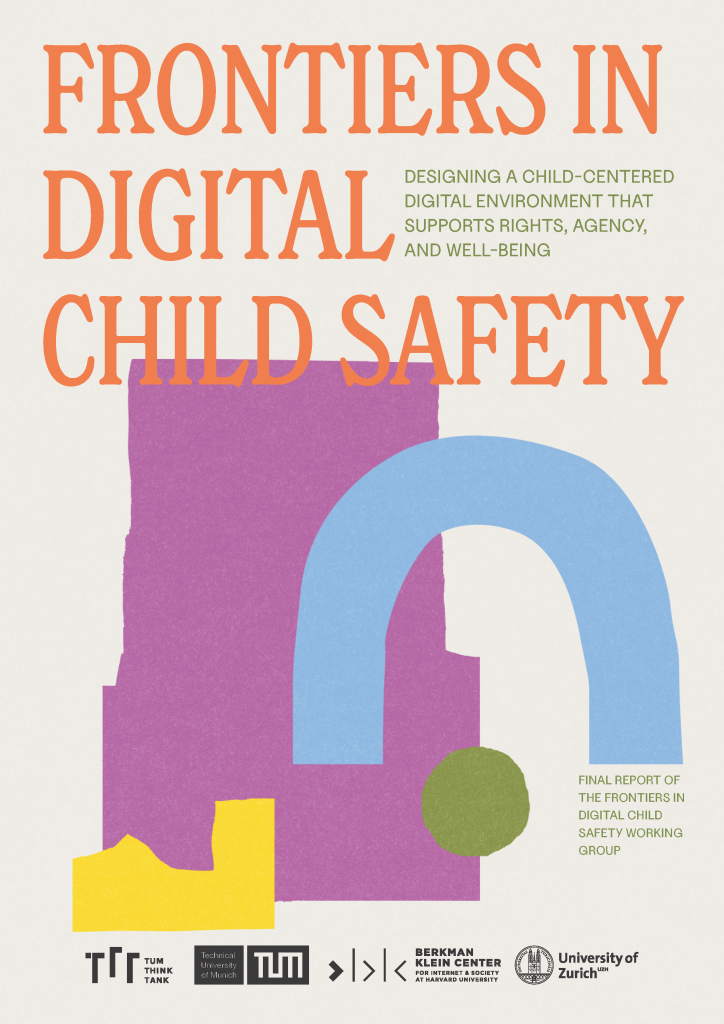
Over the last year, I had the honor of being a part of an international working group hosted by the TUM Think Tank at the Technical University of Munich along with my colleagues from the Berkman Klein Center for Internet & Society at Harvard University and the Department of Communications and Media Research at the University of Zurich. Our mission was to rethink how we approach online safety for children in today’s complex technological landscape. The result is a comprehensive report that just launched today entitled Frontiers in Digital Child Safety: Designing a Child-Centered Digital Environment That Supports Rights, Agency, and Well-Being.
The report is chock-full of important, updated insights for both researchers and stakeholders, easy to search and navigate through, and eminently citable and referenceable as both a report and a guidebook. I’d also like to quickly shout-out my longtime colleagues and friends Sandra Cortesi and Urs Gasser, who served as our fearless leaders and co-editors. While you should read the full report at your leisure, I wanted to take a moment to discuss some themes that struck a chord with me. These are grounded not only in the literature base, but also in our Center’s ongoing work with platforms, schools, youth, and families. My hope is that the following discussion sparks your interest to examine the report and find practical takeaways to weave into your own professional work as you guide the youth in your life. Ultimately, we’d like the report to serve as a springboard for new conversations and collaborations as we co-labor to translate research and policy into meaningful, real-world impact for young people.
Child Safety as a Design Opportunity
To begin, we believe that stakeholders need to view online safety not just as a protective measure, but as a proactive design opportunity. Instead of defaulting to restrictive tactics like blanket social media bans or extreme screentime limits, our working group explored how to intentionally and proactively build safety into digital environments from the ground up. This means creating spaces that prioritize children’s rights, nurture their agency and autonomy, and actively support their well-being during the tenuous developmental stage of adolescence. To be sure, we need solutions that don’t just shield youth from certain risks and harms, but empower them to personally and professionally succeed. We need tools that adapt as they grow, respect their privacy, and make safety a seamless part of their online lives. And as I’ve explained in a report I co-authored last year on what social media regulators and platforms should do, we need an approach that moves beyond compliance-driven checklists toward innovative, research-backed solutions that center children’s lived experiences.
Design That Fosters Trust
The report we launched today outlines four interconnected strategies to make this vision a reality. The first approach involves designing for trust, because trust is the foundation of any effective safety strategy. We examined how to design features – like parental controls or safety alerts – in ways that respect children’s autonomy while simultaneously keeping them safe. This means moving away from top-down restrictions toward much more collaborative models where youth and caregivers make decisions together. For example, instead of parents unilaterally disabling features, we explored tools that encourage open conversations. Transparency is key here; when youth understand why a safety feature exists and how it works, they are more likely to engage with it in positive ways rather than attempt to circumvent it.
Help-Seeking and Reporting Approaches
Young people often hesitate to report harmful experiences online because of shame, fear of overreaction, or distrust in the people or systems in place to assist them. Our group focused on how technology can lower these barriers. Better in-app tools can help, as can AI-driven features that not only recognize when a user might be in distress and encourage them to seek help or connect with trusted support, but also proactively moderate content by scanning for harmful material like bullying, hate speech, or explicit images before it ever reaches young people. It’s also about creating ecosystems where adults and peers can step in supportively in ways that truly help. We also discussed improving how reports get handled by platforms and authorities, emphasizing the need for clearer feedback loops and victim-centered processes.

On-Device Approaches to Intervene When Risks Occur
Since smartphones are primary gateways to the digital world for almost everyone, we also tackled the topic of on-device interventions. This might involve tech that blur sensitive images or flag grooming language in real time – all while processing data locally to protect privacy. The goal is not heavy surveillance and monitoring but rather the creation of guardrails and other constraining mechanisms that help kids recognize and navigate risks without undermining their independence to explore, learn, and grow. For instance, youth-specific features within an app might change and adapt as a child grows in maturity, and offer more guidance early on while gradually stepping back over time. Of course, recalibration and course correction may be necessary when immature choices are made, but this can be built into the suite of customizable controls offered to families by each platform.
Learning from Other Safety Domains
Interestingly, some of our most valuable insights came from outside the realm of technology. This is detailed much further in the report, but we looked at how warnings work in physical contexts – like product labels or public health campaigns – and applied those lessons online. The major takeaway is that educational messages must be crystal clear, emotionally resonant, and tailored to the audience. Vague alerts like “this might be unsafe” or “content warning” are far less effective than a specific, gentle prompt explaining why something online poses a risk and how to avoid it. In fact, research from other safety domains consistently shows that clear, explicit, and customized warnings with non-generic language and actionable advice are more likely to be noticed, understood, and acted upon by young people.
Visual design matters as well, in that prominent, well-designed cues such as bold colors, engaging icons, or even animated characters grab attention and enhance understanding far better than dense sentences or paragraphs of text or tiny, easily dismissed notifications. Studies highlight that warnings are most effective when they use contrasting colors, large fonts, and simple imagery to make the risk salient, and when their placement on the screen is immediate and unavoidable. For example, a red banner with a warning icon at the top of a message or a pop-up with a relatable avatar explaining the risk can significantly increase the likelihood that a child will pause and consider their actions. A small, text-heavy disclaimer buried at the bottom of a page isn’t going to do the job.
Integration and Early Education
Finally, a recurring theme in our discussions was the need to integrate digital safety into broader educational efforts. Isolating online risks and harms from topics like mental health or offline bullying misses how these issues intersect and overlap in the lives of youth. Digital citizenship and media literacy should be folded into existing programming on peer conflict and aggression, dating and healthy relationships, social and emotional learning, and other traditional topics that are generally (hopefully!) covered during the school year. In addition, research shows that programs which address root causes – like social isolation or low self-esteem – tend to be more effective than standalone cybersafety curricula. And starting early with brief, regular sessions in classrooms, afterschool environments, or via apps can help build the most critical skills over time.

Research Questions To Consider
As we push these ideas forward, I’m always thinking about future research projects, and the report details several questions that scholars and developers should explore:
- What specific on-device interventions that protect without breaching trust or privacy should be built?
- What metrics best measure the long-term impact of “safety by design” on children’s well-being?
- How can AI-driven tools minimize bias and maximize sensitivity across contexts?
- What best practices can be identified in how we can enlist youth in co-creating safety features?
I’m inspired to tackle these questions alongside fellow researchers, educators, and tech innovators. When we design with youth rather than for them, we create solutions that are both effective and empowering – and set them up for success in their developmental journey toward adulthood. That must always be the goal. I’m thankful to have been a part of this working group and look forward to further collaborations. Reach out if you’d like more information on the current work, or that which needs to be done.
Image source: Pexels, Katerina Holmes, Julia M. Cameron, and RDNE Stock Project








